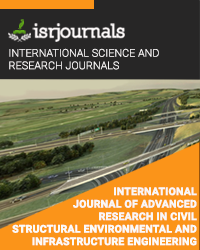decolorization of synthetic dye solution containing congo red by advanced oxidation process (aop)
Smita Venkatesh,N. D. Pandey,A.R.Quoff
Published in International Journal of Advanced Research in Civil,Structural,Environmental and Infrastructure Engineering and Developing
ISSN: 2320-723X Impact Factor:1.7 Volume:2 Issue:1 Year: 08 May,2014 Pages:49-55

Abstract
Decolorization of synthetic azo dye solution of Congo red dye, as an anionic dye was studied in a batch reactor using Advanced Oxidation Process (AOP). Congo red has been selected amongst azo dyes due to its high solubility in aquatic environment. AOP is effectively removing color in azo dye wastewater due to its strong oxidizing property by breaking down the functional group that impacting color on azo dye. AOP selected in this study was the ozonation. The effect of ozonation contact time on initial dye concentration, solution pH and the rate of decolorization were studied and the results were analyzed in terms of color removal efficiency. The color removal efficiency was found to increase with an increase the ozonation time and decrease with an increase in initial dye concentration of the synthetic dye solution. The result with Congo red synthetic dye solution showed that maximum decolorization around 90% was obtained at 25 min of ozonation.
Kewords
decolorization; advanced oxidation process (aop); ozonation; batch reactor; congo red.
Reference
[1]. C. Tizaoui and N. Garima, Kinetics of the ozone oxidation of reactive Orange 16 azo-dye in aqueous solution, Chem. Eng. J., 173, 463_473, 2011. [2]. H. Ali and S. K. Muhammad, Bio-decolorization of acid violet 19 by Alternarsia solan, Afr. J. Biotech., 7, 831_833, 2008. [3]. A. Lopez, G. Ricco, R. Cinnarella and A. C. Di Pinto, Textile wastewater reuse: ozonation of membrane concentrated secondary effluent, Water. Sci. Tech., 40, 99_105, 1999. [4]. M. Faouzi, P. Caizares, A. Gadri, and J. Lobato, Advanced oxidation processes for the treatment of wastes polluted with azoic dyes, Electrochemica Acta., 52, 325 _ 33, 2006. [5]. M. Coca, M. Pena, and G. Gonzalez, Variable affecting efficiency of molasses fermentation wastewater ozonation, Chemosphere, 60, 1408_1415, 2005. [6]. O.S.G.P. Soares, J.J.M. Orlao, D. Portela, and A. Vieria, Ozonation of textile effluents and dye solutions under continuous operation: influence of operating parameters, J. Hazard. Mater., 137, 1664_1673, 2006. [7]. O. Legrini, E.Oliveros, A. M. Braun, Photochemical processes for water treatment, Chem. Rev., 93(2):671_698, 1993. [8]. N. Genc and E. Can-dogan, Photooxidation: A decolorization procedure and a pre-treatment step for biodegradation of reactive azo dye. Polish Journal of Environmental Studies, 15(1):73, 2006. [9]. L. Kos and J. perkowski, Decolorization of Real Textile Wastewater with Advanced oxidation processes, Fibres & Textiles in Eastern Europe, 11(4):43, 2003. [10]. A.K. De, B. Chandhuri, S. Bhattacharya and B. K. Dutta, A practical application of the advanced oxidation process for wastewater treatment, India. Chem. Eng. Section, 41(2): 63_66, 1999. [11]. S. F. Kang, C. H. Liao and T. S. Po, Decolorization of textile wastewater by photo-Fenton oxidation technology, Chemosphere, 41, 1287_1294, 2000. [12]. J. H. Churchley, Removal of dye waste colour from sewage effluent: The use of a full scale ozone plant, Water Sci. Technol., 30, 275_284, 1994. [13]. J. Fernandez, J. Riub, E. Garcia-Calvo, A. Rodriguez, A. R. Fernandez-Alba and D. Barcelo, Determination of photodegradation and ozonation by products of linear alkylbenzene sulfonates by liquid chromatography and ion chromatography under controlled laboratory experiments, Talanta, 64, 69_79, 2004. [14]. APHA-AWWA-WPCF, Standard methods for the examination of water and wastewater, 16th edition. Washington DC, 1985. [15]. APHA–AWWA–WEF, Standard Methods for the Examination of Water and Wastewater, 20th ed., APHA – AWWA –WEF, Washington, DC, 1998. [16]. A. B. C. Alvares, C. Diaper and S. A. Parsons, Partial oxidation of hydrolyzed and unhydrolysed textile dyes by ozone and the effect on biodegradability, Trans. Inst. Chem. Eng.,79, 103_108, 2001.

